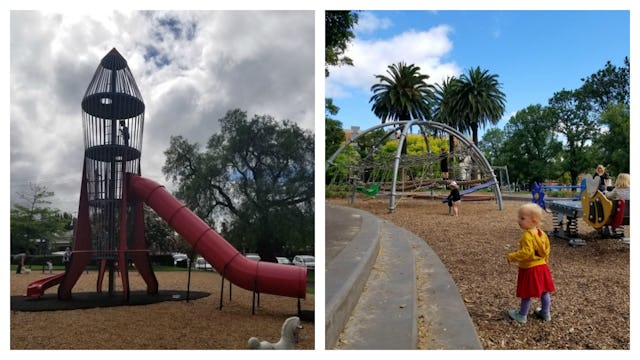America Should Take Notes On Australia's Public Parks

Over the holiday break, my family and I traveled to Melbourne, Australia for 2 weeks with our two toddlers. Like any young child, they have a lot of energy, and they’re happiest when they can run and play outside. We knew that they’d need plenty of time at the nearest playground.
Erin Skinner Cochran
Aussie friends assured us that Melbourne had no shortage of great playspaces, and that they were on a whole other level than what we are accustomed to in DC. This is a country with play spaces as unique as a dinosaur-themed adventure playground and a kids’ space inspired by tennis stadiums – complete with child-sized grandstand and commentary box.
But here’s the thing that really struck me: They get all of the basics right.
1. They’re everywhere. Literally.
2: They’re built for a range of ages. Toddlers, teens, you name it.
Erin Skinner Cochran
3. They have running, sometimes even filtered water. (And it’s cold and refreshing.)
4. In many cases they have public restrooms on site.
Erin Skinner Cochran
5. if you really hit the jackpot, there are even snack shops!
Erin Skinner Cochran
Don’t most playgrounds have tap water available, a public bathroom and a variety of play structures for different ages? Not in DC. More often than not — even at the newer playgrounds — the water fountains don’t work at all. If they do, either a dribble of water comes out — the kind your kid can only consume if they lick the spout. Don’t even think about cold water either. That’s a luxury.
If we’re paying tax dollars for — among other things — public drinking water, why can’t the city ensure that all playgrounds have (cold) tap water available onsite from water fountains? Everyone knows how hot it gets in our swampy summers. Keeping young people hydrated is important. We should make it easy for them to do so.
As for the public bathrooms, you’re lucky if your playground has them. If they do, why are they mysteriously locked all the time? What’s the point of having them if you can’t use them? For a lot of parents with potty-trained kids, let alone parents of teens, where their kid can go to the bathroom is an actual consideration when debating which playground to visit. If there isn’t one and your house is more than a 10-15 minute walk away, it’s not worth it, especially on a hot day.
Snack shops? Hope for the ice cream truck to come by.
The lack of these amenities is exactly why I feel as if I pack for Armageddon whenever I take my kids to the playground in Washington. You have to go prepared for it all — the poop accident, the hunger pains, the natural thirst from all of the exercise. And if you run out of water or one of your kids has an emergency bathroom run, pack it all up; you’re heading home.
You can argue that it’s my job — not the city’s — to bring food, water and diapers for my kids. You’re not wrong. But after two weeks in and around Melbourne’s playgrounds, I sure didn’t miss having to pack as if I was headed out on a wilderness excursion. And when they had to go to the bathroom, we didn’t have to call it a day, head home or sprint to the nearest coffee shop.
First world problems these may be, but there’s something bigger and more symbolic to all this. When city planning is done well for families, basic services, like working water fountains and public toilets, send a signal to its citizens: We care about and want the best for you.
That’s the kind of place I want to raise a family.